Fruit flies are a nuisance but it is good to know that it is easy to get rid of fruit flies in plants.
They appear in droves, seemingly out of nowhere.
According to the University of Kentucky, fruit flies can appear year-round but are most common during late summer and fall because ripened and fermented food and vegetables are what they are attracted by.
Fruit flies do no harm to houseplants, but they are unsightly and pesky.
Given where they live and eat, they are also a health hazard.
They will lay their eggs in a warm, damp environment such as the soil of your houseplants, close to a ready food source.
They are attracted by fungus buildup and debris in the plant soil that they also favor for the often damp conditions.
Table of Contents
How to get rid of fruit flies in plants?
There are multiple proven methods to get rid of fruit flies in plants. Firstly, change the environment so it is no longer attractive for fruit fly feeding or breeding. Secondly set a trap, using their favorite food source as bait. Thirdly, strategically place a carnivorous plant near the affected area. Finally, use plants that repel insects. If you do not have space for another plant, a few leaves scattered on the surface will suffice.
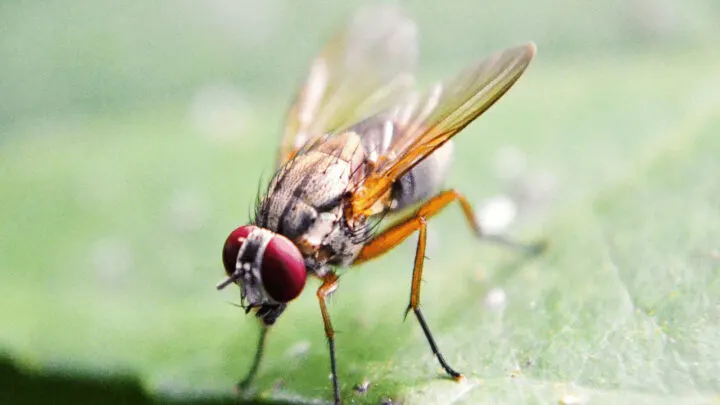
Fruit Flies in the Home
‘Fruit flies’, otherwise known as ‘vinegar flies’, ‘wine flies’ or ‘yeast flies’, are prolific, polygamous breeders, and are found in most places where food is served.
Drosophila melanogaster, to give it its scientific name, is a fairly simple creature, having only four pairs of chromosomes and a rapid breeding cycle.
They are very popular with researchers, including six recipients of Nobel Prizes.
You might feel less enamored with them if they decide to invade your home.
The first action to take when you spot fruit flies is to look for the source of the infestation.
Their most common hangouts are the garbage bin and bowls of overripe fruit.
If you remove the garbage often and keep fruit under cover or refrigerated, this should eliminate a large part of the problem.
Regularly clean surfaces where food is prepared as well.
If you have a container in the kitchen for keeping scraps for the compost heap, it could also be a source of fascination for the pesky fruit flies.
Ensure that the container seals tightly and that you decant the contents to the exterior compost heap or bin frequently.
The inside of the refrigerator also requires frequent wipe downs. Fruit flies have no problem living in frigid conditions.
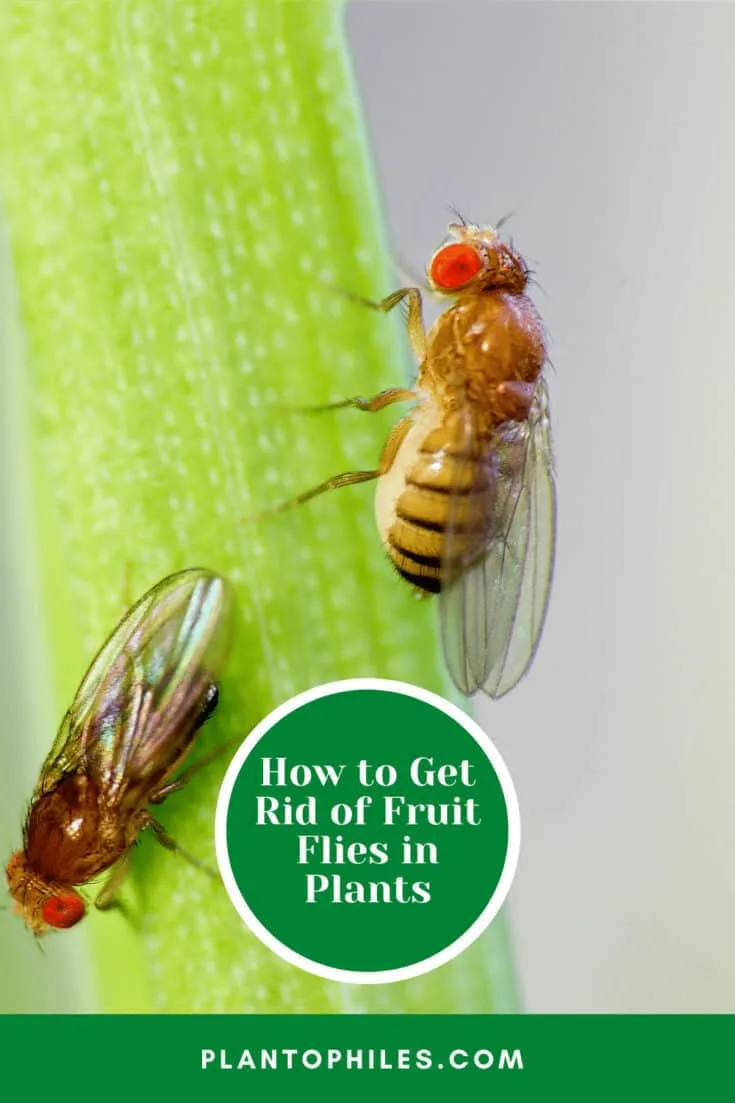
5 Proven Ways to Get Rid of Fruit Flies in Plants Naturally
1. Disturb the soil
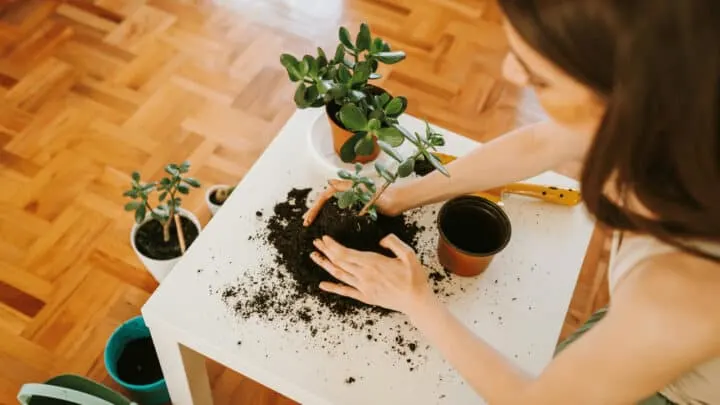
Fruit flies will be attracted to your plants for two reasons.
They will feed off the decaying matter in the soil and any fungus that is growing on the soil or in folds and crevices in the plant itself.
They will also lay their eggs just below the surface of the soil where the larvae will thrive on the micro-organisms living in the dark, damp soil.
The healthier your potting soil, the greater the chances are that fruit fly larvae will find what they require.
Disturbing the soil regularly will upset the breeding cycle.
This can be done by turning the surface of the soil over and exposing the eggs or larvae to the light and relatively dry air above ground.
You could also put a barrier between the soil and the open air, that is difficult for the larvae and fledgling fruit flies to penetrate. A thick layer of course gravel is a good remedy.
Another way to compromise the eggs and larvae is to allow the top layer of the soil to dry out completely.
Ensure that the plant can tolerate this temporary drought.
If the problem persists, it may be time to repot your plant.
Deprive the larvae of air by placing them in a sealed plastic bag.
Discard the infected soil far away from your home and garden. Sanitize the pot before reusing it.
2. Remove the food source
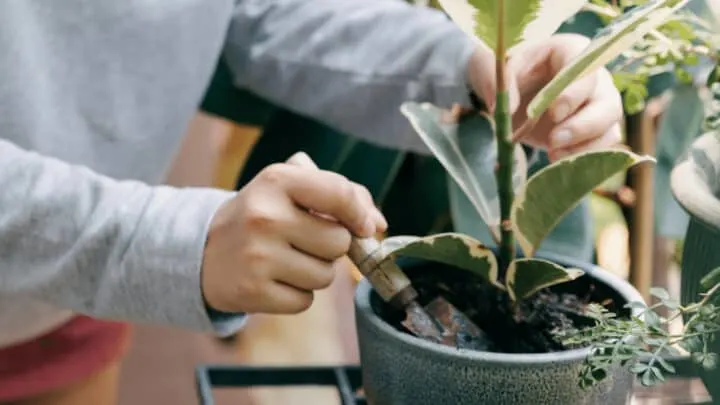
By removing any fungus buildup from your plants, you will remove one of the fruit flies’ favored food sources.
Control fungus by reducing the humidity in the environment.
Spray the plant with dishwashing liquid or wipe it down with rubbing alcohol to deter fungal growth and colonization by other harmful pests.
3. Set traps for the fruit flies
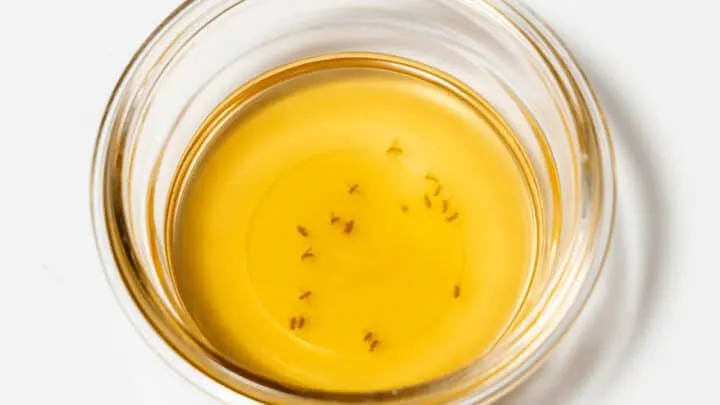
As their aliases imply, fruit flies are attracted to vinegar, wine, and yeast.
These can be used to set traps for them that they will find irresistible.
Apple Cider Vinegar mixed with dishwashing liquid and water is a successful combination.
The fruity vinegar draws them in.
The fruit flies expect to be able to walk on the surface of the liquid while they drink their fill.
Sadly for them, the dishwashing liquid breaks the surface tension of the liquid, they fall in, and drown.
Mix the liquid concoction in a dish and cover it with cling wrap.
Punch holes in the plastic, big enough for a fruit fly to fit through.
If they escape the liquid, they will find it difficult to penetrate the plastic to make their escape.
Place the trap close to the plant that has been infected. Remove the dead flies on a regular basis.
A trap of a completely different nature would be a carnivorous plant.
There are over 700 species of flesh-eating plants found around the world.
There are several to be found on every continent.
Thankfully, they also survive by way of photosynthesis so they will not die once they have consumed all the available fruit flies.
4. Plants that repel insects
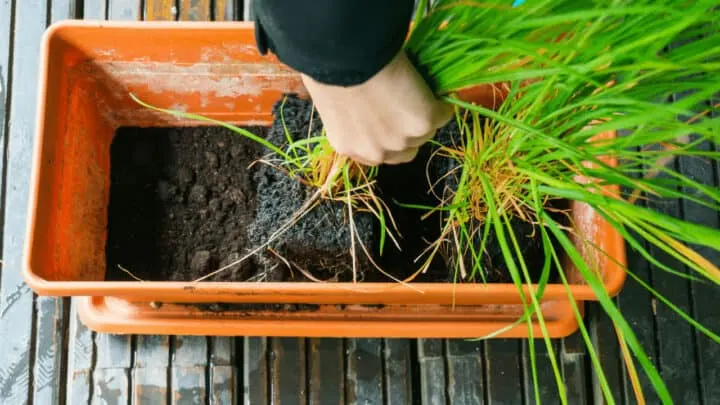
Herbs such as basil, peppermint, lavender, and lemongrass are popular house plants that are known for their ability to repel insects.
Some are seasonal and have their own requirements for thriving so care needs to be taken when placing them.
If space is at a premium, the leaves of these herbs can also be placed around the base of an affected plant or in a muslin bag nearby.
Essential oils derived from any of the above-mentioned plants, as well as eucalyptus leaves and camphor trees are also a great way to keep fruit flies away from plants.
They are put off by the smell and move away.
If these oils are burnt as incense, the smoke could kill the fruit flies.
Camphor and cedar chips can be used to cover the surface of your house plants and to act as a mulch.
The natural oils in the chips deter plant pests.
Note that the chips can be harmful if chewed by pet dogs and cats so caution is required if this is likely to happen.
5. Cover the topsoil of your houseplants to prevent fruit flies

Fruit flies live for 8 to 15 days and a female can lay up to 2000 eggs at once.
By covering the topsoil of your houseplants with gravel, pebbles, or sand you prevent fruit flies from laying eggs in the first place.
Fruit flies prefer the topsoil to lay their eggs and once it is covered they are out of a suitable breeding ground.
In addition and probably more importantly, the maggots that hatch from already laid eggs in the soil will not be able to get to the surface of the soil.
How to kill fruit flies in plants
Maybe you’ve had enough of watching miniscule black flies ruin your carefully curated indoor jungle aesthetic. Or perhaps you find yourself constantly waving your hand in front of your face in your garden to swat away the pesky creatures.
Wherever your infested plants are located, if you’re feeling fed up, you’ll probably want to eliminate the unwelcome insects.
Here are a few ways to exterminate fruit flies and fungus gnats:
1.Use a bowl and soap trap to get rid of fruit flies
The bowl and soap trap trick is great. Simply add four to five drops of dishwashing soap to a cup or bowl of vinegar. Leave it around the infested area and wait for the flies to flock to it.
Make sure you clean your bowl of dead flies and refill it with the solution regularly.
2. Use hydrogen peroxide to eliminate fruit flies
Fill a spray bottle with one part hydrogen peroxide and four parts water.
If your plant has fungus gnats (the little flies that live in plant soil), spray the surface of your plant’s soil with the homemade solution and mix it in with your fingers.
You should use gloves to do this as hydrogen peroxide can irritate skin.
Repeat this process every other day for a week. Then, transition to doing it once per week. Hopefully, this solution should solve your problem over time.
3. Dry out soil to get rid of fruit flies
One of the most old-school ways to rid yourself of a fly infestation is to keep the soil of your plants relatively dry.
Now, this is a balancing act. Obviously, if you keep your soil too dry, your greenery will suffer and you’ll notice wilting and plant leaves curling upwards.
The main thing is not to find yourself wondering how to revive and overwatered houseplant, as this level of water will make the fly-like gnats want to stick around. Try to allow the soil to almost dry out completely between waterings.
4. Use sticky traps to deal with fruit flies
If you want a quick solution to the little gnats flying around your plants, you can purchase sticky strips and place them on the surface of your soil.
One great tip for working with sticky traps is to cut them up into smaller pieces so that you can place them in more places on the surface of your plant’s soil.
While this solution will certainly get rid of any flies and gnats that come into contact with the sticky surface of the strips, it won’t do much to eliminate the larvae and maggots beneath the soil.
This means that this method is best used in combination with repotting your plant and applying a hydrogen-peroxide solution to the compost.
5. Repot your plant to rid it of fruit flies
Repotting your plant means giving it a new home. Think about it this way: if your home was infested with fruit flies or fungus gnats, the easiest way to get rid of them would be to move.
Of course, it is totally unreasonable to move because your house has fruit flies in it. However, it is a whole lot cheaper to buy new soil and a pot than to buy a new house.
So, give your plant a new home to help it escape fungal gnats.
Repotting a plant involves removing it from the soil it’s currently in and replanting it in new soil. Take care not to damage its roots when doing so.
Wash your plant’s roots gently with warm water. Fill a clean pot to the 1/3-mark with fresh compost. Then hold your plant in place and fill in the remaining compost around its roots. Water it and place it in a sunny spot.
Voilà, your plant is now living in larvae-free soil. Make sure you take other precautions to keep fungal gnats at bay, because there will likely be one or two eggs, larvae or maggots that have managed to cling on to your plant’s roots.
A soap and bowl trick or sticky traps would work a treat. Massage a neem oil solution into the new compost for a chemical-free way to treat your soil.
How to get rid of small flies in plants
Have you noticed little flies zipping through the air around the lower stems of your plant? If so, you might be confused about what they actually are.
After all, to solve a problem, you first have to know what it is.
Your first thought upon seeing a buzzing insect might be, “that looks like a fruit fly.” However, if you’re like most of us, you probably don’t know how to distinguish one kind of tiny fly from another.
Here is an explanation of the difference between fruit flies and fungus gnats. Read on for tips on how to identify the two most common types of small black flies and instructions on how to clear each infestation.
Fungus gnats
Fungus gnats are responsible for almost all houseplant fly infestations. They live in and lay eggs in soil and their larvae feed on dead roots and rotting plant material.
Fungus gnats are usually 1/8 of an inch long. Their long back legs give them a mosquito-like appearance.
One tell-tale sign that the buzzy creatures living in your plant are fungus gnats is that they stay right around the surface of the soil. Because they aren’t talented fliers, they move abruptly in spurts and straight lines.
Their heads are black, but their bodies are transparent. Gnats are particularly prominent during the colder months when soil takes longer to dry out.
If there are small flies living in the soil around your plant, you can assume they are fungus gnats.
If you want to get rid of fungus gnats, you need to know why they are attracted to plants.
The root of the problem (no pun intended) when it comes to fungus gnats, is generally that decomposition of some kind is occurring in and around your plant. Funnily enough, it is usually rotting roots that cause fungal gnats to flock to a plant.
Keep an eye out for symptoms of root rot to avoid attracting fungus gnats in the first place.
After all, tackling a fungus gnat infestation means taking a two-prong approach.
The first prong is getting rid of the flies. This means repotting your plant and then using sticky traps and insecticide to eliminate the gnats.
The second prong is preventative. This means ensuring that you do not overwater your plant and removing any dead plant matter from its soil.
Adopting these two methods at once should clear your infestation over the course of just a few weeks.
Drosophilid flies (fruit flies)
Fruit flies take up residence anywhere where decomposing fruit and vegetables can be found. Whether you have an overfull food-waste container in your kitchen, or a fruit tree with rotting fruit beneath it in your garden, you may find yourself subject to a fruit fly epidemic.
The biggest clue to identifying fruit flies is in the name. Fruit flies love overripe fruit. Well, they love any kind of rotting food, really. They aren’t that picky.
In order to get rid of fruit flies, you’ll want to make sure you’ve correctly identified what the insects causing you problems are.
Fruit flies are not good for human hygiene or health. They are known for transferring germs and bacteria to clean surfaces, including salmonella, E. coli, and listeria, all of which can cause food poisoning.
To keep yourself and your household healthy, read the next section on how to eliminate fruit flies.
The best way to get rid of fruit flies is to set traps for them. Collect and clean out empty jars. Then, pour a bit of vinegar, dish soap and vinegar, yeast and water, or wine into the bottom of the jar.
Use cardboard, paper, or thin plastic packaging to create a cone shape with a hole at the bottom and place this over the open jar.
Leave these around the infested area. The bugs will be attracted by the smell and enter the jar through the hole in the cone. Once in there, they will struggle to get out and will drown in the liquid mixture.
You can also hang up fly-tape, which is generally used to trap black flies, but is just as effective at getting rid of fruit flies.
In addition to these solutions, you should also take preventative measures, such as cleaning the surfaces of your kitchen and ensuring there is no old food lying around.
Scrub out your trash, recycling, and food-waste containers to ensure there is no food residue rotting on their sides.
If fruit flies are gathering on the ground around outdoor or potted indoor fruit trees, ensure you remove any fallen fruit and other plant matter before it begins to rot.
How to get rid of fruit flies that are in the soil of the plant
If you’ve ever wondered how to get rid of fruit flies in your plant’s soil, you aren’t alone. However, those little buzzy bugs are not actually fruit flies. They are called fungus gnats!
The most effective long-term way to clear a fungus gnat infestation in your plant’s soil is to repot your plant.
Because fungus gnats have such a high rate of reproduction and such short lifespans, your soil will likely contain larvae and maggots almost as soon as the first gnat touches it.
You may even have seen some of these larvae and wondered, “what are these tiny little worms?”
This means that getting rid of fruit-fly-like fungus gnats is more complicated than just spraying the surface of the soil with vinegar.
Even if you are able to end the gallivanting of the most mature gnats using this method, their successors are probably already squirming away below the surface.
As a result, you’ll want to repot your plant. Wash its roots thoroughly with lukewarm water before placing it into new soil in a clean pot. Then, make sure you keep the soil relatively dry and don’t overwater it over the coming weeks.
How do you get rid of fruit flies without harming plants
When you start to notice unusual movements around the base or in the leaves of your plant, your first thought might be, “I hope I don’t have to throw that out.”
After all, most plant enthusiasts feel pretty attached to their potted and free-growing green friends.
Given the amount of care and time that goes into making sure these lifeforms prosper, it’s no wonder you’d feel devastated at recognizing a fruit fly or fungus gnat infestation.
When treating your plant, you’ll probably be wondering how you can get rid of the flies without damaging the greenery they have taken up residence in.
The best ways to get rid of plant flies that won’t cause any damage to the plant they’re occupying are as follows:
- repot your plant in fresh soil
- cut up potatoes and place them on the surface of the soil to trap larvae
- massage a hydrogen-peroxide-based solution into the soil without making contact with the plant’s roots
- allow soil to dry out between waterings
- use a soap and bowl trap
- place sticky traps on the surface of the soil to catch any straggling survivors
Once you have taken these steps, monitor the situation.
If you still see little flies buzzing about around your plant after two weeks or so have passed, you may need to take more drastic action, such as getting rid of the plant altogether.
Conclusion
Fruit flies are pesky insects that you will come by almost certainly in your home and as part of your houseplant-keeping career.
Once you spot fruit flies it is important to identify why they came in the first place.
There almost always is a food source such as ripe and overripe fruit present or the soil of your plants is very wet and soggy attracting fruit flies.
If you act fast – as fruit flies are prolific breeders – and follow the tips outlined in this article you almost certainly will get rid of these pests sooner than later.
Frequently asked questions on “Fruit flies in plants”
What fruit fly spray can be used for plants?
There are several sprays you can buy to get rid of fungus gnats living in and around plants. You’ll generally want to go for a biodegradable insecticide for larvae and plant bugs. You can also use a fungicide to aid with gnat removal. Getting rid of fungal spores gets rid of the stuff the gnats feed on, which makes your plant less attractive.
Can fruit flies kill plants?
As a rule, fungus gnats (the little black flies that live in the soil of houseplants), generally don’t cause plants to die. They are unattractive and annoying, but rarely cause any long-term damage to the plants whose soil they are occupying.
Do fruit flies eat plants?
The fungus gnats that live in plant soil and are commonly mistaken for fruit flies do not eat plants. Their larvae do eat dead plant matter, such as rotted roots or decomposing leaves. However, you do not need to worry about them nibbling away your plant’s leaves.
How do fruit flies reproduce?
Fruit flies reproduce by laying eggs. Females lay as many as 2,000 eggs on wet, rotting surfaces. Within two days, those eggs become maggots, which eat the rotting matter they were laid on. Just a few days after that, those maggots have become flies.
Can fruit flies come from plants?
The fruit-fly-like fungus gnats that live in plant soil can come from plants if eggs have been laid in the soil around them. However, plants do not create fruit flies. If a fruit fly is attracted by decomposing matter, either in or around a plant, it might lay its eggs in the compost. This will result in the development of fruit fly population around the plant.
Are fruit flies bad for plants?
“Not really,” is the short answer to this question. As a rule, the fungus gnats that look like fruit flies and live in plant soil do not cause damage them. However, if an infestation gets too bad, the larvae in the soil may eat up many of the available nutrients. In extreme cases, this can result in yellowing or wilting leaves.
Can plants attract fruit flies?
Plants attract fungus gnats if there is rotting matter on or around them. Fruit flies are attracted to rotting fruit, so if a fruit tree has rotting fruit on it, there is a good chance it will soon become a host to fruit flies. However, neither fruit flies nor fungus gnats are attracted to plants themselves.

Daniel has been a plant enthusiast for over 20 years. He owns hundreds of houseplants and prepares for the chili growing seasons yearly with great anticipation. His favorite plants are plant species in the Araceae family, such as Monstera, Philodendron, and Anthurium. He also loves gardening and is growing hot peppers, tomatoes, and many more vegetables.


